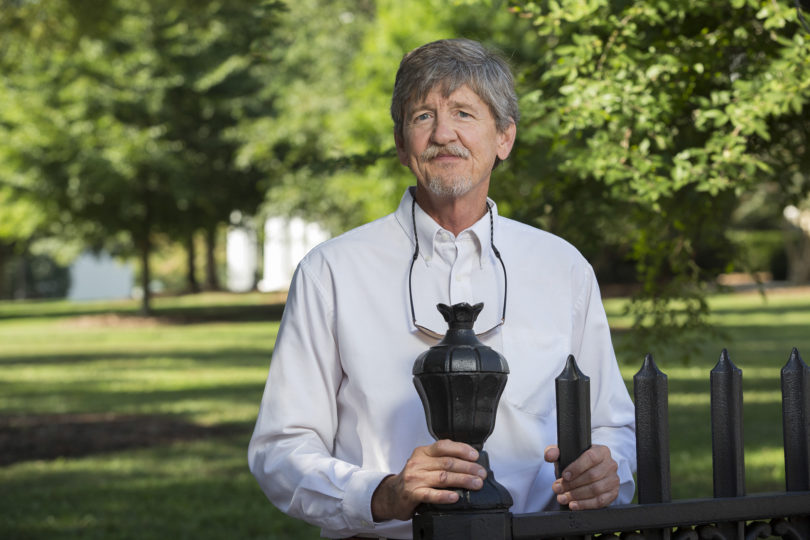Students arriving on UGA’s campus in the 1970s found a somewhat beleaguered landscape: bare, eroding clay banks along Lumpkin Street, old chairs and beer coolers strewn in Tanyard Branch, poorly defined walkways and little sense of a pedestrian connection between North and South campuses. The landscape needed someone who understood that this is a campus for people in a naturally beautiful Piedmont setting.
Gordon Chappell, former director of the grounds department, set the stage for a more healthy and invigorated campus in the 1980s, and, along with design manager David Hale, inspired Dexter Adams in his work. Current director of the grounds department, Adams will retire Sept. 30 after 31 years on campus.
A “Double Dawg,” Adams received his bachelor’s and master’s degrees in landscape architecture from the College of Environment and Design in 1976 and 2004, respectively. An avid gardener, Adams has seen the campus flourish. In addition to his work in the Facilities Management Division, Adams has served his alma mater by helping student designers with projects and serving in class critiques. He also has a personal interest in the Founders Memorial Garden, which was conceived and created by the college’s founder, Hubert Bond Owens. Adams talked with Columns about his time at UGA:
Columns: What are some of your favorite places on campus?
Adams: The town spring (just down the hill from the Tanner building), Founders Memorial Garden and Herty Field on North Campus. The remnant spring is such a quirky reminder of our beginnings, the intersection of historic preservation and ecology. The Founders Garden represents my own beginning in landscape architecture and the wonderful partnerships we’ve been able to sustain with academic departments across campus. I’m fond of Herty Field because it was designed and built entirely in-house, thanks to staff alumni David Hale and Kimo Polster.
Columns: Is there an aspect of managing a campus landscape that you find particularly challenging?
Adams: Is there any land use quite like a large university campus? It’s a fascinating combination of history, beauty and heavy-duty infrastructure that is in a constant state of construction, replacement and repair. This puts tremendous pressure on the campus landscape and requires steady vigilance to protect trees, minimize damage to plantings and not violate the integrity of historic spaces.
Columns: How do you feel about prescriptions for sustainability?
Adams: The landscape as a thing of visual pleasure, of beauty, can be an end in itself. But a landscape that does a job for you as well is especially worthwhile. I hope we’re showing that they need not be mutually exclusive. Landscapes should require less water, less “chemical” management and not create collateral damage to the surrounding environment. If, in the process they can clean the water and air, then you’ve given your customer the complete package. At least that’s what satisfies me professionally.
Columns: Are there any aspects of your career here of which you are especially proud?
Adams: I fell backwards into landscape architecture and had actually never heard of it before entering the program in 1973. I’m proud of the fact that I found a
field-environmental design-that I could believe in. Specifically, by assembling a great staff and thanks primarily to them, I’m proud of the entire campus, its composition and its management. And don’t get me started on composting…all that “stuff” was being landfilled when I got here. Now, if you don’t show signs of life within a few minutes we compost you into a wonderful soil amendment. People come from all around to check out our Bioconversion Center.
Columns: Are there any other beneficial campus landscape changes that you have witnessed?
Adams: The campus is more collegial, more democratic. It was managed in a very heavily top-down fashion in the past. There is improved accountability and costs are much more carefully monitored. At one time we could smother a problem with resources; no more. We now plan better, execute better and allocate restricted resources better. We now actually operate under a master planning process, and our offices have developed extensive standards for building and site construction. Some awful development occurred here and elsewhere between World War II and the 1980s. It is a much better process now governed, mostly, by solid guiding principles. Kudos to Danny Sniff and his staff here (in the Office of University Architects). I’ve tried to ensure that our organization is a good soldier in the implementation of the plan.
Columns: What do you plan to do with your time once you retire?
Adams: I’ve had a job since I was 14 so this is all a little weird. I have no big plans, just lots of little plans. My son Sam, who has special needs and is one of the best people I know, volunteers in the Founders Garden. I look forward to spending more time with him and the rest of the family. We live on a nice chunk of old family farmland, and I have unfinished projects everywhere.
Columns: Do you have any recommendations for students of landscape design that you’d like to share?
Adams: Get dirty and do a sketch every day.








